The Reef Beach Company's Internet Brochure
| Our mission is to help restore and protect natural sandy beaches in an ecologically friendly way through the development and use of natural looking and ecologically sound, Reef Balls in specific arrays for site specific erosion control. Reef Balls are state of the art designed artificial reefs modules with sizes and anchoring techniques developed specifically for submerged breakwater use. Reef Ball Submerged Breakwaters have been used in the Dominican Republic, United States, Mexico, Cayman Islands, and Antigua with many new projects being planned for other locations. Reef Balls as submerged breakwaters to create or protect a beach work best in areas with low tide ranges and when the 2-3 meter depth contour line is far enough off shore to create a reasonable swimming area (usually at least 25 meters). |
The Reef Beach Company
171 Eichorn Blvd.
La Falda, Argentina
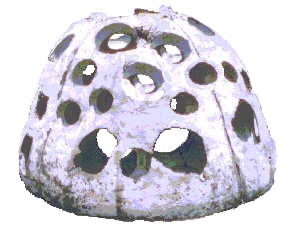
[Pictured above is a Reef Ball.
They come in many sizes from 6 inches to 6 feet
and ranging from 6 to 6,000 pounds]
Why Build Reefs to Protect or Create Beaches?
Man's activities and natural disasters have led to a reductions in our natural reef systems and reduced reef systems often mean increasing erosion on our beaches. Other factors, such as shoreline changes, littoral construction, and even global weather patters continue to make eroding beaches a problem. Beach "renourishment" is not only temporary, it is often environmentally damaging requiring expensive mitigation, extensive permitting issues, and can even be the source of public outcry. Reef Balls can be a permanent solution, yet one that is removable in the event of a change in plans. Building reefs, however, does more than just stop erosion, reef are a natural asset to a beach providing snorkeling, diving, fishing or even coral reef restoration using our coral propagation and transplanting system which is cost effective and can provide the look and feel of a natural fringing barrier reef in just a few years. What better way to protect or form a beach that the way mother nature does it on her own?
What's Involved
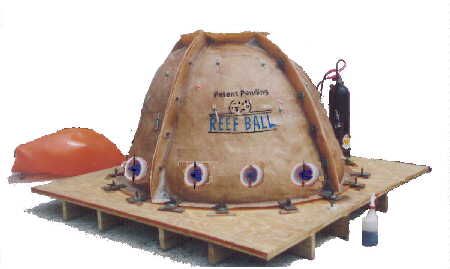
Reef Ballstm are made by pouring concrete into a fiberglass mold (shown) containing a central Polyform buoy surrounded by various sized inflatable balls to make holes. Specific anchoring adaptations are added depending upon the type of seabed where the submerged breakwater is to be built. There are a variety of sizes of Reef Ball heights available to allow a custom fit with the bathometry of the planned reef.
Our engineering teams will visit your site, gather the data you already have and collect site specific data to create for you an initial proposal with approximate costs and to prepare for the more detailed engineering phases that may be required for permitting and construction.
Floating Deployment
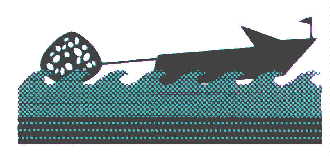
Reef Ballstm are cast around an extremely durable Polyform bladder. This bladder can be left in the unit to provide flotation so the Reef Balltm can be towed behind any size boat. Once at the site, the bladder is deflated and removed. When divers are used, the unit can be placed precisely on the sea floor with a controlled descent even allowing construction to take place next to or fit around natural reefs. If desired, the units can be deployed by barge. Having both options provides for the option of choosing the most economical or most rapid approach to construction.
Unique Hole Sizing & Placement

Natural reefs are variable in size, shape and hole density. Artificial reefs function better when they mimic nature. The balls which create holes are inflated to different pressures to vary hole sizes. Interconnected holes are possible by inflating the balls until they touch. These hole patterns can be customized to affect water flow in and around the breakwater for maximum effectiveness.

[This is a Bay Ball(tm) which weighs 325 pounds and is 3 feet wide and 2 1/2 feet high. Three different surface textures were applied (rubber mat, surface retarder, and air entrainment).]
Surface Textures
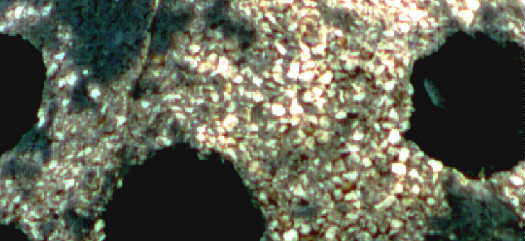
[The Above Close Up Shows Aggregate Exposed By Using Sugar Water On Molds]
A variety of surface textures that enhance the settlement of marine life are available. When a submerged breakwater is covered by natural marine life, the breakwater can exert more drag and become even more effective. In locations where suitable, hard corals can be planted to cause the breakwater to grow over time to an even more effective shape.
Stability
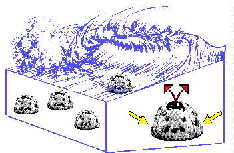
Reef Ballstm are designed so that over half of the weight is in the bottom near the sea floor. We have developed a variety of anchoring techniques to insure Reef Ballstm are stable. Reef Ball submerged breakwaters have withstood direct hits from Cat. III hurricanes without any movement. There are several unique properties in the design that helps with stability. For example, the opening in the top of the unit breaks up the lifting force of the hydrofoil effect common to dome shapes. Side holes are wider near the center of the walls and narrow near the units surface. This feature creates miniature vortexes which further reduce lifting forces, put added drag on waves and even help to bring rich nutrients to life on the reef. Reef Ballstm for submerged breakwaters are typically cast up to double the standard weight of a biological reef ball to accommodate high energy zones. Our staff will help you determine the best way to insure stability.
Check out our Stability Analysis By Florida Institute of Technology
Marine Friendly Concrete
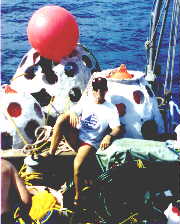
[Deployment By Atlantis Submarine in Cancun, Mexico-Allen Force pictured]
The concrete used to make Reef Balls features W.R. Grace's Force 10,000 micro silica to create a super high strength, abrasion resistant, concrete that has a pH similar to natural sea water. This is unlike regular concrete which has a surface pH as high as 12. This high pH (the sea has a natural pH of 8.3) can inhibit the settlement and growth of many species of marine life including some larval corals. Micro silica gives Reef Balls an expected life of 500 or more years and greatly increases the abrasion resistance of the concrete, this is important so that sand moving past Reef Balls does not wear down the surfaces of the Reef Balls.
Reef Ball Sizes, Weights, Volume & # of Holes
| Style | Width | Height | Weight | Concrete Volume |
Surface Area |
# Holes |
| Goliath | 6 feet | 5 feet | 4,000-6,000 lbs | 1.3 yard | 230ft2 | 25-40 |
| Super Ball | 6 feet | 4.5 feet | 4,000-6,000 lbs | 1.3 yard | 190ft2 | 22-34 |
| Ultra Ball | 5.5 feet (1.83m) |
4.3 feet (1.37m) |
3,500-4,500 lbs (1814-2722 kg) |
.9 yard 0.76m3 |
150 ft2 13.9 m2 |
22-34 |
| Reef Ball | 6 feet (1.83m) |
3.8 feet (1.22m) |
3000-4200 lbs (1360-2722 kg) |
0.75 yard 0.57m3 |
130 ft2 12.1 m2 |
22-34 |
| Pallet Ball | 4 feet (1.22m) |
2.9 feet (0.9m) |
1500-2200 lbs (680-998 kg) |
0.33 yard 0.25m3 |
75 ft2 7.0 m2 |
17-24 |
| Bay Ball | 3 feet (0.9m) |
2 feet (0.61m) |
375-750 lbs (170-340 kg) |
0.10 yard 0.08m3 |
30 ft2 2.8 m2 |
11-16 |
| Mini-Bay Ball | 2.5 feet (0.76m) |
1.75 feet (0.53m) |
150-200 lbs ( kg) |
less than 4 50 lb bags |
8-12 | |
| Lo-Pro | 2 feet (0.61m) |
1.5 feet (0.46m) |
80-130 lbs ( kg) |
less than 2 50 lb bags |
6-10 | |
| Oyster | 1.5 feet (0.46m) |
1 foot (0.30m) |
30-45 lbs ( kg) |
less than 1 50 lb bag |
6-8 |
Bold numbers are estimates in above chart
COSTS
Submerged Reef Ball breakwaters are highly variable in costs depending upon the unique site conditions. 100 meters larger sized Reef Ball protection can range from $200,000 to $1,000,000. We can provide you with a proposal giving you your range of options. Generally, we send down a team of 2-4 experts to do the initial site survey. Fees are generally around $700/day per expert plus expenses. Contact us with details of your proposed project and we can help you with more specific ranges.
![]() Technical Specifications
Technical Specifications
for Comparing To Other Reef Materials
Learn the gross tonnage equivalency, macro & micro surface area, bio-mass carrying capacity and number of "fish" holes in the various sizes of Reef Balls for comparing to other artificial reef materials. You'll see why Reef Balls are the BEST value for your budget!